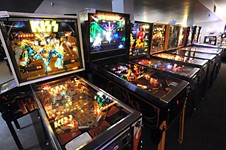Sinking Deeper
Robin Arnott explores the outer limits of video-game immersion
By James Renovitch, Fri., April 15, 2011
Playing sound designer Robin Arnott's experiment in immersion, Deep Sea, is a trust exercise. Will you agree to have a modified gas mask put over your head, a joystick placed in your hand, your vision blacked out, breathing closely monitored, and normal room sounds replaced with the eerie groans of an unfriendly and elusive sea creature? If so, you – brave or unwitting soul that you are – might find yourself removing the mask prematurely and to great relief.
"Somebody took off the mask, and about a minute later I heard him shout from across the hall, 'It's amazing to breathe without consequence!'" says Arnott, referring to the game's biofeedback mechanism that amplifies a player's breathing back into the headset, effectively obscuring any undersea audio baddies that might be nearby. Control or hold your breath; either way, don't expect to be comfortable.
Arnott is one of a growing number of indie game designers who have abandoned the notion that video games should be fun, choosing instead to focus on the interactive experience. He describes Deep Sea, without any reservation, as an intensely negative experience: "It is uncomfortable, and deliberately so. It's difficult. It's frustrating. And, to some players, it's scary."
It goes without saying that you won't find his joystick/gas mask combo on the shelves of Best Buy any time soon – or ever – but Arnott never expected otherwise. After a commission from the Game Center at New York University, where he was studying film, Arnott was able to take a break from his more lucrative position as the one-man audio design studio Wraughk to explore video-game design – an interest that was born from a class in experimental theatre that proved to him what medium the real artistic troublemakers were working with: video games.
After showing Deep Sea at NYU's No Quarter exhibition of digital games, Arnott made his way to Austin and found himself on the short list of finalists for South by Southwest's inaugural indie gaming competition, ultimately taking home the Intel award for innovation (although strangely not winning in the Best Audio category).
Aside from some national attention, the original commission funds from NYU, and a computer that came with the SXSW award, what else can the man behind the mask really expect from his unsellable but highly regarded piece of equipment? Like many artists willing to take risks without fear of monetary ruin, Arnott imagines "something about the experience that can germinate into more commercial and accessible projects." Multimillion dollar game projects can't risk experimentation, relying on the little guys to show them the future. Perhaps the combination of biofeedback and sense deprivation will be used in an underwater level of Super Mario Galaxy 5. Or not.
In a perfect world, Arnott would be able to easily raise funds for his more ambitious follow-up game. "What I'm working on next? I'm trying to do the opposite of what I was doing with Deep Sea. Instead of using sense deprivation to create an intensely negative, scary experience, I'm trying to use sense overload to create a synesthetic, euphoric experience," says Arnott. "I really want to incorporate sexual stimulation into the synesthetic experience." Sounds like an interactive and pornographic version of Willy Wonka's psychedelic boat trip. Tell me there's not a market for that.













